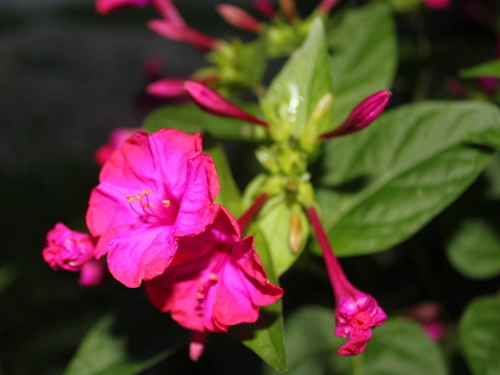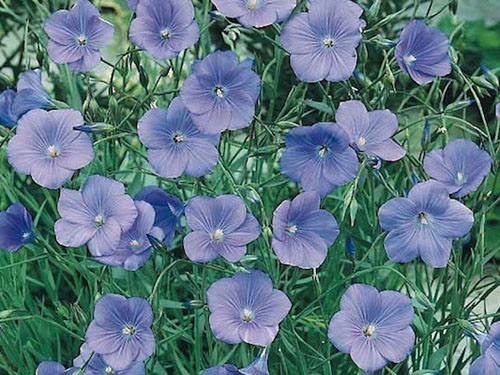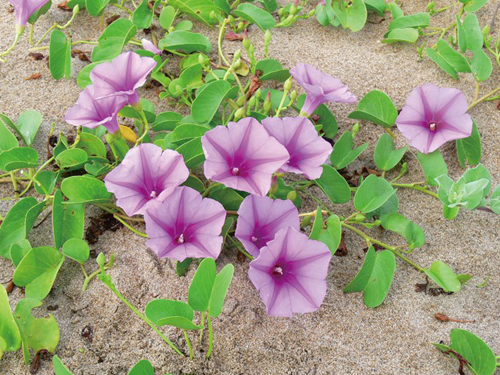Culture of purple jasmine (grass jasmine, rouge flower)
Purple jasmine (small mine, grass jasmine, rouge, night incense) scientific name: mirabilis jalapa
Alias: pink bean flower, supper flower, number one flower, night incense and other families and genera: purple jasmine family
Morphological features: perennial herbs-annual cultivation, 50cm to 100cm high. Stem with conspicuously dilated nodes. Leaves simple, opposite, ovate. On the involucre of several flowers, the calyx is petal-shaped, trumpet-shaped, red, orange, yellow, white, pink or striped, spotted or alternately fragrant. The fruit is black and the surface is wrinkled and angled, commonly known as small mines.
Ecological habits: sexual preference for mild and humid climatic conditions, not cold-resistant, the aboveground parts withered in winter, the underground parts in the south of the Yangtze River can safely survive the winter and become perennial grass flowers, and continue to grow new plants in spring next year. Open-field cultivation requires deep, loose and fertile loam, pot cultivation can be used-like flower culture soil. It grows better in slightly shaded places. Flowers bloom from evening to early morning, close in strong light, grow and blossom well if there is shade in summer, and defoliation often occurs in the scorching sun. Like good ventilation and good environment.
Florescence: summer and autumn.
Fancy words: cowardice, timidity.
Garden use: flowers open from dusk to early morning, closed in the hot sun, and fragrant at dusk. The flower border is dotted with forest edges, hedges and buildings.
Species identification: there are many kinds of flowers alias "night incense", which are often confused.
① polianthes tuberosa Amaryllidae.
② evening primrose oenothera biennis willow plant family, blooming at night, full of fragrant flowers.
③ jasmine jasminum sambac rhinocerosaceae, shrubs, white flowers, fragrant, blooming from early summer to late autumn.

Introduction to the culture of purple jasmine
Purple jasmine is native to tropical America. It is often cultivated in the north and south of China for ornamental flowers, sometimes in the wild. Roots and leaves can be used for medicine and have the effects of heat-clearing and detoxification, promoting blood circulation, regulating menstruation and nourishing. Seed powder can go to facial mole acne. So how much do you know about Mirabilis? What is the use of purple jasmine? What is the breeding method of purple jasmine? The following will be introduced to you by the editor, hoping to be of some help to you.
Introduction to the function of purple jasmine
Introduction of purple jasmine alias rouge flower, bath flower, night Jiaojiao, tide flower, grass jasmine, palace powder flower, number one red, etc., is a perennial erect herb of purple jasmine family, which is often cultivated as annual flowers in production. Achene globose, black, with longitudinal ribs and reticulate texture, shaped like a mine, also known as a small mine. The endosperm in the seed is white, the powder is fine, and it can be applied instead of lead powder. It is an ideal natural cosmetics. The weight of a thousand seeds is 90-130 grams. The root is fusiform, fleshy, the surface is brownish black. Like plenty of sunshine, slightly resistant to semi-shade, but afraid of the scorching sun. Not cold-resistant and afraid of heat, afraid of frost, like fertile and loose soil. The suitable temperature for seed germination is 20-22t. Sandy bed soil is beneficial to seedling growth and likes bed soil to be moist. The function of purple jasmine 1. Ornamental value: there are many colors of purple jasmine, and the flowers are as small and lovely as trumpet flowers. Purple jasmine flowers are not in full bloom during the day, but at night, flowers are numerous and have a faint fragrance, so it is a kind of ornamental plant that is easy to feed. It can be used for potted or wild plants. two。 Medicinal value: as a flower of purple jasmine family, it not only has high ornamental value, but also its medicinal value is inestimable. Purple jasmine seeds are black in shape and round in shape, but their seeds have the wonderful effect of heat-clearing and detoxification. If they are ground internally and then matched with some ingredients, they can form good cosmetic beauty for acne, freckles and so on. Purple jasmine leaves can disinfect the wound, interpret the effect, put a pot of purple jasmine indoors, has a good mosquito repellent effect. Is purple jasmine poisonous?
The outer part of Mirabilis is not poisonous. So aquaculture is quite suitable, and many parts of it can make medicine, but the poison is the root and seed of purple jasmine. Generally, if you eat these parts by mistake, then its symptom is tongue numbness. Then the sense of hearing, vision and touch will be reduced, body pain, the solution is vomiting or sent to the hospital emergency.
Culture method of Mirabilis jasmine
Cultivation method of purple jasmine 1. Soil: it is better to choose fertile sandy and semi-sandy soil. Planting in slightly acidic soil with pH 6 to 6.5 can make the root system dense and grow healthily. 2. Watering: Jasmine is not resistant to drought, but avoid stagnant water. In summer, hot and sunny days should be watered twice a day, once in the morning and evening, if the leaves are found to curl and droop should be sprayed on the leaves to promote growth, the rainy season should often loosen the soil, so that there is no water in the basin. 3. Lighting: Jasmine is fond of inflammation, heat, humidity, ventilation and breathable environment, which requires sufficient light. Jasmine is a light-loving plant, its growth and development needs sufficient light, and long-day direct light is more beneficial to its growth and development. Strong light, thick green leaves, stout branches, many buds, good coloring and high aroma; if the light is insufficient or too shaded, the leaves are light green and the leaves are large and thin. 4. Temperature: Jasmine is sensitive to temperature, which requires warm, hot and humid climate and can adapt to higher air temperature, but it is not resistant to low temperature and poor cold resistance. When the temperature is below 10 ℃, jasmine grows very slowly, even stops growing. The buds can sprout at about 19 ℃, the buds can only be conceived at more than 25 ℃, and the buds can form and develop well at 30-40 ℃. 5. Fertilization: the high temperature season in midsummer is the peak period for jasmine growth, applying more organic fertilizer and phosphorus and potassium fertilizer, such as peanut cake powder, bone powder, calcium superphosphate and multi-element flower fertilizer, twice a month. Purple jasmine culture method purple jasmine alias also known as night prosperity, rouge, bath flowers, supper flowers, purple jasmine good viewing period: from July to October. Ornamental features: perennial grass flowers, plant height 60 to 100 cm. Flowers are clustered on top of branches, Corolla saucer-shaped, apex 5-lobed, flowers with red, pink, yellow, white and spotted complex colors, usually bloom in the evening or after sunset, and close or wither the next morning. The flowering period is relatively long and can be cultivated in the open field in the south. The flowers bloom continuously from early summer to late autumn. Suitable environment: like warm, humid environment, not cold-resistant, the suitable temperature for growth is 25 to 35 degrees. Neither drought nor waterlogging. Like light, slightly resistant to shade, grow well in a little shade. Breeding methods: commonly used sowing and reproduction. It can be sowed by itself after flowering, and manual sowing is usually broadcast in the open field or flowerpot in spring. Cuttage propagation can also be used, generally from June to October, and the rainy season is the best in the south. Select the sturdy branches of the year, cut them into 6 to 10 centimeters, with 3 to 5 buds, retain 2 to 4 leaves, moisturize after insertion, and take root in 10 days. In addition, ramet propagation can be carried out in spring or autumn, and pay attention to watering and shading. Cultivation management and protection: during the growing period, more organic liquid fertilizer should be applied, supplemented by phosphorus and potassium fertilizer. After the flower is withered or picked, the heart should be picked in time to promote its sprouting so as to keep the plant shape plump. In order to keep green and evergreen, 0.25% ferrous sulfate should be applied once in about 15 days. In the case of lack of water or low air humidity, new branches are not easy to germinate, while stagnant water can easily lead to rotten roots and fallen leaves. It is best to plant in a sunny and well-ventilated place. If the light is not enough, the leaves are large, the nodes are thin, and the flowers are small. Courtyard collocation: purple jasmine has rich and colorful flowers, long flowering period and fragrance, which can be planted in the courtyard, in front and behind the house, by the side of the hedge, especially suitable for rest in the evening or cool at night.
- Prev

Cultivation methods of flax (safflower flax, large flax)
Flax (safflower flax, flax) scientific name: linumgrandiflorum morphological characteristics: annual herbs, plant height 40-50 cm. Stem erect, basally branched. Leaves alternate, grayish green, linear-lanceolate. Flowers solitary, pedicels slender, flowers pendulous, Corolla 5-lobed
- Next

Management method of thick rattan (horseshoe grass, climbing vine flower)
Thick rattan (saddle vine, horseshoe grass, sea potato, climbing rattan) scientific name: ipomoeapes-caprae family: rotational flower family alias: thick vine, Limulus, sweet potato, lion vine, Dichondra, horseshoe grass, Hairuteng. Morphological features: perennial herbs, stem creeping ground. Leaves alternate, thickly leathery
Related
- Fuxing push coffee new agricultural production and marketing class: lack of small-scale processing plants
- Jujube rice field leisure farm deep ploughing Yilan for five years to create a space for organic food and play
- Nongyu Farm-A trial of organic papaya for brave women with advanced technology
- Four points for attention in the prevention and control of diseases and insect pests of edible fungi
- How to add nutrient solution to Edible Fungi
- Is there any good way to control edible fungus mites?
- Open Inoculation Technology of Edible Fungi
- Is there any clever way to use fertilizer for edible fungus in winter?
- What agents are used to kill the pathogens of edible fungi in the mushroom shed?
- Rapid drying of Edible Fungi

